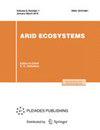基于罗斯托夫地区卡门斯克地区埋藏土研究的中青铜时代古生态条件重建
摘要
在罗斯托夫地区Kamensky地区,在青铜时代中期的yamnaya -地下墓穴文化边界,进行了古生态条件重建。本研究是基于对kurgan 1号考古对象“Malaya Kamenka VI”组的土壤调查结果。确定古黑钙土和现代表层土为粘壤土和壤土,质薄,腐殖质含量中等,形成于类黄土壤土上。土壤上层的pH值几乎为中性。古土壤腐殖质层pH值呈平缓上升趋势(7.0 ~ 7.3),表明碳酸盐地层表面抬升。古土壤成因层中Cl -离子含量在0.15 ~ 0.30之间%, \({\text{SO}}_{4}^{{2 - }}\)—0.04–0.09%, and Mg2+—0.007–0.020%, that higher comparing to modern surface soil. It can be an indicator of more arid paleoecological conditions. Short soil profile of paleosol, the footmarks of huge soil animals activity, traces of phytomass burned, a higher soil mass boiling point in paleosols are indicators of the arid climatic phase. In paleosol the low content of pollen from woody and shrubby plants in pollen spectra (up to 6.5%) and a large proportion of pollen from xerophilic species: wormwood (up to 17%), other the Asteraceae family plants (up to 20%), Ephedra pollen finds (up to 2%), indicates an increase of arid conditions. Vegetation was similar a dry steppe with the part of xerophilic grasses. The modern surface soil characteristics (traces of leaching of carbonates from the topsoil, the absence of salinity in the profile) and significant part of motley grass in pollen spectra reflect more humid and favorable conditions at present.

Reconstruction of paleoecological conditions on the territory of the Kamensky district of Rostov region, in the Middle Bronze Age yamnaya–catacomb culture border, has been carried out. The work based on results of soil investigations of kurgan 1, archaeological object “Malaya Kamenka VI” group. It was set up that paleochernozems and modern surface soils are clay loam and loamy, thin and having medium humus content and formed on loess-like loams. Values of pH in upper soil horizons are almost neutral. Increasing of pH in humus horizons of paleosols are of smooth character (from 7.0 to 7.3), which indicates carbonate formations surface upliftment. The content of Cl–-ions in the genetic horizons of paleosols are in the values 0.15–0.30%, \({\text{SO}}_{4}^{{2 - }}\)—0.04–0.09%, and Mg2+—0.007–0.020%, that higher comparing to modern surface soil. It can be an indicator of more arid paleoecological conditions. Short soil profile of paleosol, the footmarks of huge soil animals activity, traces of phytomass burned, a higher soil mass boiling point in paleosols are indicators of the arid climatic phase. In paleosol the low content of pollen from woody and shrubby plants in pollen spectra (up to 6.5%) and a large proportion of pollen from xerophilic species: wormwood (up to 17%), other the Asteraceae family plants (up to 20%), Ephedra pollen finds (up to 2%), indicates an increase of arid conditions. Vegetation was similar a dry steppe with the part of xerophilic grasses. The modern surface soil characteristics (traces of leaching of carbonates from the topsoil, the absence of salinity in the profile) and significant part of motley grass in pollen spectra reflect more humid and favorable conditions at present.

 求助内容:
求助内容: 应助结果提醒方式:
应助结果提醒方式:


